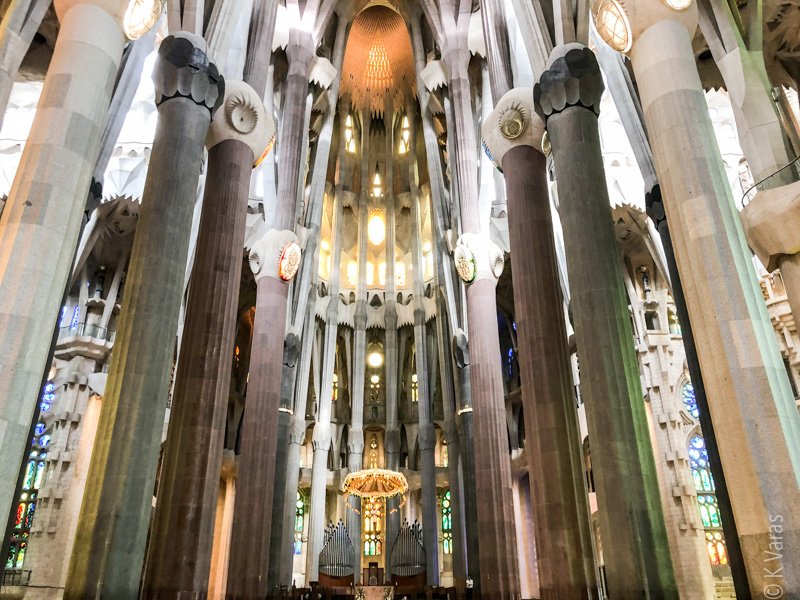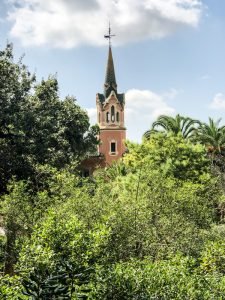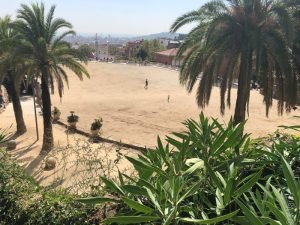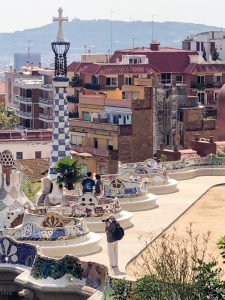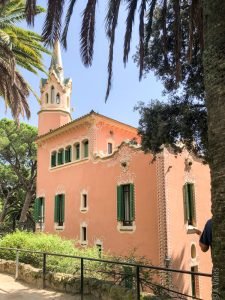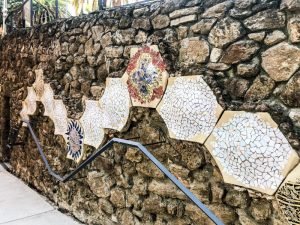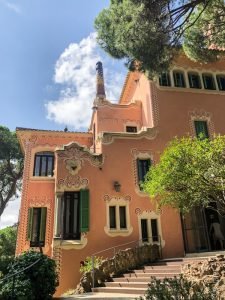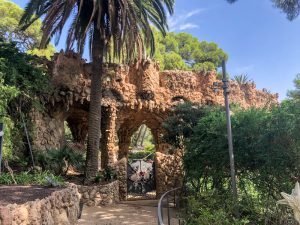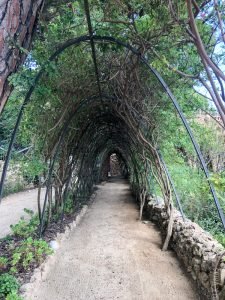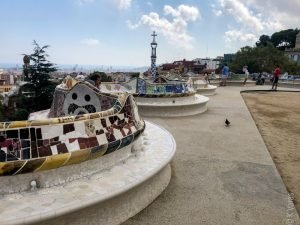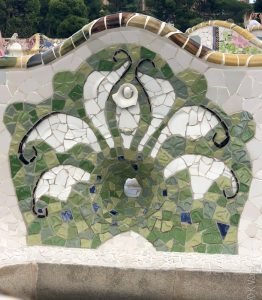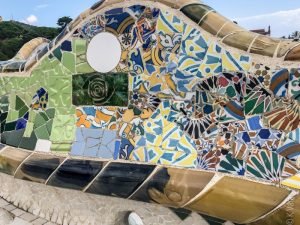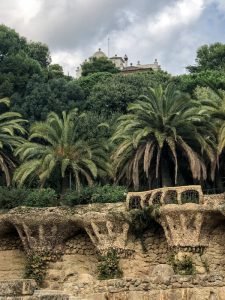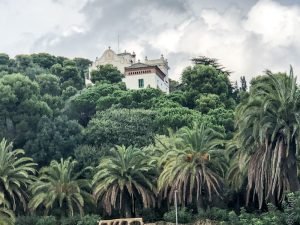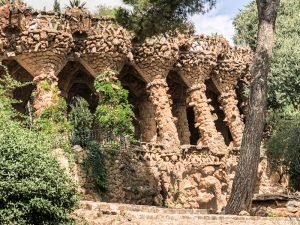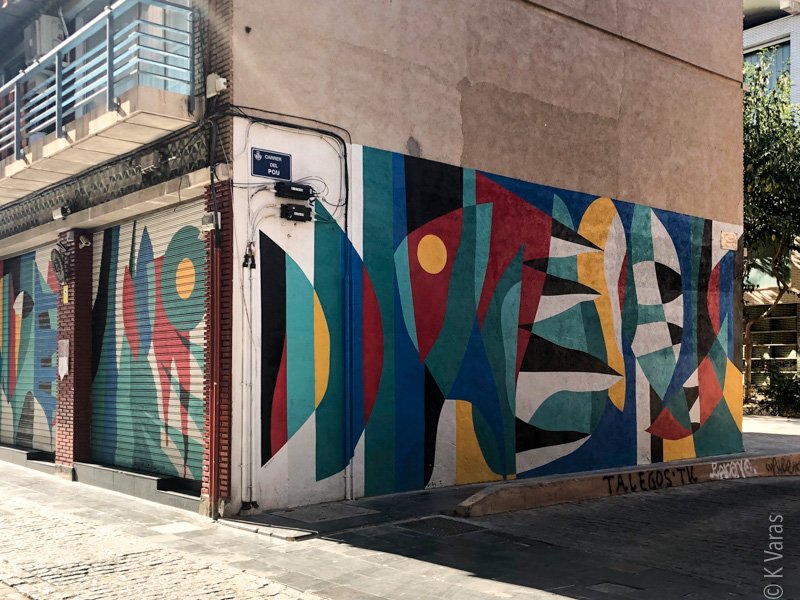
Park Guëll
This was not my first visit to Park* Guëll and I’m sure it will not be the last. I really love strolling through the hillside walkways, listening to the crazy parakeets squawking at each other and the palomas (doves? They sure don’t look like the pigeons I’m used to), and dodging the tourists. Oh wait, right, there were no tourists. There were a few at the famous curvy balcony that surrounds la Plaça de la Natura, most of them French, but the numbers were low. Absent, as well, were the previously ubiquitous sellers of junky tourist accessories that littered the area back in 2011 and 2013. I’m not sure if their absence is due to better policing of the area or Covid-19, but it is a welcome change, for sure.
Park Guëll has a very interesting history; it is fascinating how some failures are really successes in the long run. Back in 1900, Eusebi Guëll was already a big fan of Gaudí’s, a patron and friend to the great architect. Being a man of means and an entrepreneur, he had a plan to transform the previously barren Muntanya Pelada, a hill just north of the village of Gràcia, into an exclusive gated housing development. The site was divided into 60 parcels and a model house was built. Unfortunately, other than the model house, only one other lot was sold and a house built: Casa Martí Trias i Domènech, which looks a little lonely atop the hill, but I am sure the views from it are magnificent and the lucky people who live there now don’t mind the isolation.
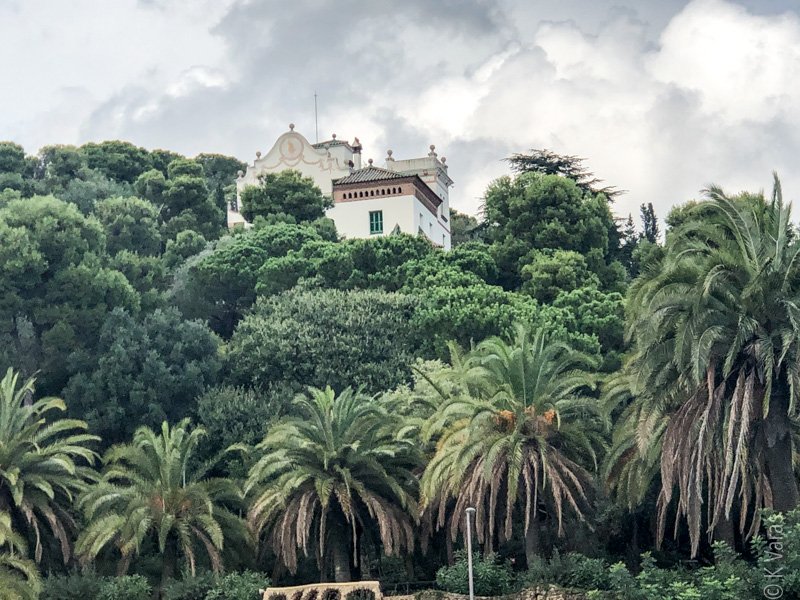
The commercial enterprise was a bust; it seems few people wanted to buy a house so far out of town, and in the early 1900s, this was far out of town. Guëll and Gaudí did the next best thing, however, and made lemonade out of the proverbial lemons: they built a park that would benefit all barcelonins. The park is a testament to Gaudí’s genius, his homage to nature, and a place where he introduced a multitude of Mediterranean trees and plants to create a lush space full of nooks and crannies that invite discovery. He respected the terrain and instead of forcing his vision on the mountain by excavating or levelling parts of it, he built raised walkways on columns that look like big tree trunks.

I took many more pictures of some of the iconic areas on my previous visits, mainly because the most popular part of the park, i.e. the two gate houses, à la Hansel and Gretel, the Barcelona Salamander, and Sala Hipóstila (or Hall of Columns), are now in the paid zone and I wasn’t about to spend a €10 to see them yet again. I would have loved to, don’t get me wrong, especially with so few people around, but it did seem a little excessive. I could just add those pics to the Gallery and you wouldn’t even know it 😉 The nice thing is, it costs nothing to visit 90% of the park, and, judging by the number of locals present, people do take advantage to walk through it a lot.
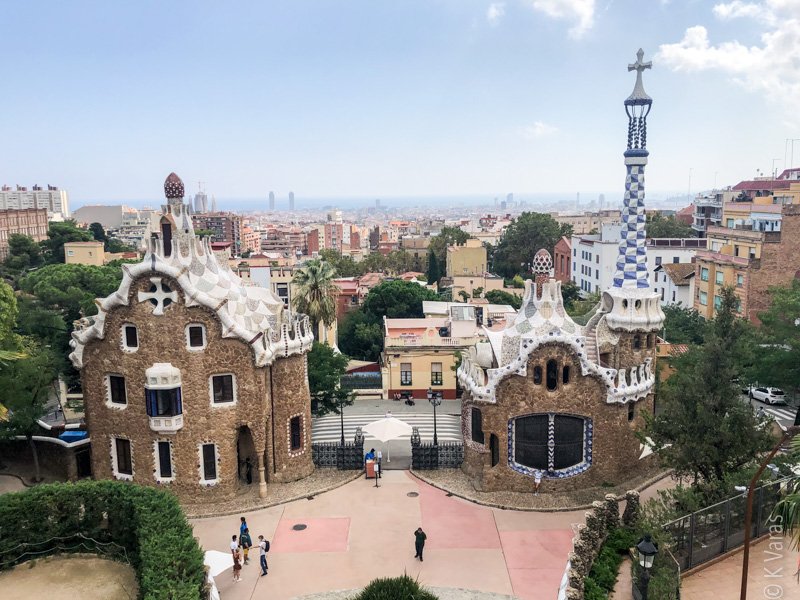
I forgot to mention that when I got my ticket for Sagrada Família, I also got the add-on for Gaudí House Museum. This house is in fact a show house built to entice people to buy properties in the new development. It was designed and built by Gaudí’s right-hand man, Francesc d’Assís Berenguer i Mestres, and eventually purchased by Gaudi himself who lived in it for some 20 years, or until he moved into the workshop at Sagrada Família. It’s a very lovely house, though, unfortunately, not decorated in a way I would have hoped. Other than a few examples of furniture designed by Gaudí, and the sparse, almost monastic bedroom and study, you really have to use your imagination to picture what the place looked liked a 100 years ago. Nevertheless, the spaces themselves really are wonderful, with plenty of light, colour (mostly in the floors and ceilings), and interesting alcoves. It would have been a fun house to live in. The gardens, too, have a playful feel to them, with a long, curving pergola I would assume looks lovely when the plants are in bloom (though I’m not sure what they are, to be honest).

It really is too bad that nobody designs homes like these anymore. Catalan Modernist architecture may not be for everyone, but you can’t deny that it is just so lovely to look at. It is joyous and brings a smile to my face every single time I see an example of it. Some people have said that the adjective gaudy, meaning “tastelessly ornate or showy”, comes from Gaudí’s name. This is, quite simply, preposterous. In fact, this word was in use long before Gaudí was born. It actually comes from the obsolete English word gaud, meaning “joke, toy, or showy ornament,” which in turn comes from Old French gaudir “to rejoice, make merry, to jest, scoff at” from late Latin gaudre “to rejoice,” a descendant of Latin gaudere “rejoice, be joyful.” So, today’s negative gaudy is a perversion of the original “happy and joyful.” And isn’t that original meaning so appropriate for Gaudí’s work, however coincidental it may be to the spelling of his name? It’s almost as if being gaudy in the original sense of the word was his birthright, one that he most definitely lived up to.
* The “Park” in Park Güell is spelled with a “k” and not “c” which would be the normal spelling in Catalan. This is because the local Spanish authorities were jerks and did not want to allow the Catalan spelling so, instead, the English word was used. The Spanish word for “park” is, of course, “parque.” It also helped that the project was based on an English-style garden park.

